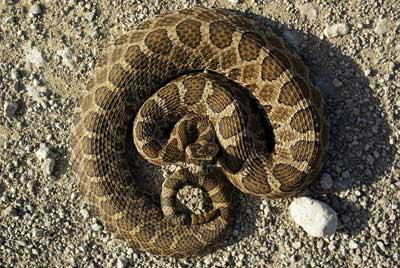|
back Home Life Along a
|
|
Western Massasauga
Sistrurus catenatus tergeminus|
© Jim Saueressig II, www.kansashorizons.com |
Western Massasaugas are smaller as adults than the other rattlesnakes found in Oklahoma, but otherwise can be difficult to distinguish from other species. Adult Western Massasaugas are generally 45-75 cm in length, but can grow up to nearly 90 cm. Like other rattlesnakes, they have hollow scales at the end of their tail that make a warning rattling noise, but the small rattle at the tip of the massasauga’s tail may only make a small noise which may not be heard until you are too close! These snakes mate in Fall or Spring. Females give birth to 4–8 live offspring in August or September. The young are born with fangs and are venomous from birth. Western Massasaugas are carnivorous and have a varied diet, including frogs, lizards, other snakes, and rodents. The Western Massasauga lives throughout western Oklahoma, but not in the panhandle. In general this snake lives west of the Mississippi River and east of the Rocky Mountains. The name, massasauga, is said to mean “swamp dweller” or “great river mouth” which may refer to its habitat of marshy areas or wetlands near river deltas. They prefer low, swampy areas close to marshes, lakes, and rivers, but can also be found in grasslands. They are relatively common in undisturbed habitats of western Oklahoma, but rapidly disappear from areas that have been converted to agriculture. |
|
back to species list |
PDF of all species profiles
|

